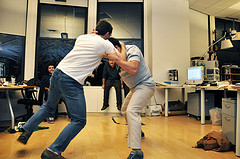Last week, we wrote a blog post titled “IT Staffing Solutions: How To Find A Fit For Your Team.” While we explained that being flexible with fit and project duration helped you find a whole new pool of candidates, we didn’t explain how to choose the best from among these fish.
So how do you choose the best from this new pool? You test them. While they may not be filling in bubbles on a multiple-choice exam, they will be tested on their knowledge and personal skills. Today’s blog post will help you understand what kinds of post-candidate generation testing are needed to find the best fit for your team.
1) Test Those Skills
Would you buy a new car without test-driving it? My guess is, probably not. You do the research, find the car to be a good fit in theory, and then test-drive it to make sure. This process also goes for potential employees. Once you’ve identified the skills you’re looking  for, and find a candidate who fulfills this criteria, you need to test whether or not the candidate can actually perform these skills.
for, and find a candidate who fulfills this criteria, you need to test whether or not the candidate can actually perform these skills.
What do we mean? It’s simple. Ask them to perform the duty they’ll be completing. If you need someone to write Java, watch them code Java. If you need someone to explain complex business problems to others, have them explain complex business problems to you. By asking candidates to perform technical skills before you hire them, you get the added reassurance that you won’t have any surprises down the line. You’ll know what they’re capable of, and won’t have to second-guess yourself as they sign their contract.
2) Understand What Makes This Candidate Tick
Every candidate has a different reason for taking a new position. Some are searching for more money, others for more challenging problems, while the rest are looking for a more exciting atmosphere. By asking the right questions, you’ll be able to determine which of the three is true for any given candidate.
The importance of understanding what makes a candidate take a new position cannot be underestimated. If your star candidate is looking for a large and exciting atmosphere, and you’re a small company with ten employees, this may not be the best fit. There’s a higher chance that they’ll leave early, and backfilling this position can (and will most likely) be painful. Make sure that your candidates are sold on your company. If they are, they’ll be a better fit for your team.
3) Look For An Interpersonal Fit
Your team is a close-knit group that understands how to work with one another. You don’t want to disturb that balance, do you? No? That’s what I thought.
If you don’t want your team to lose it’s groove, you need to make sure that your candidates  would get along well with your current team. Analyze their personality. Are they talkative? Disruptive? Silly? Will these personality traits mesh with the personalities of the people on the team? If no, move on to your next candidate. If yes, hold on tight!
would get along well with your current team. Analyze their personality. Are they talkative? Disruptive? Silly? Will these personality traits mesh with the personalities of the people on the team? If no, move on to your next candidate. If yes, hold on tight!
In our years in the IT staffing and technical consulting field, we’ve found that there are two types of sought after candidates. The first are the brilliant individuals capable of moving mountains. The second kind? Capable people that communicate well and are a joy to work with. It may be tempting to go with the first type of candidate, and many do, but often regret not hiring the second type when team personalities start clashing. Make sure you don’t make this same mistake. Team personalities make a huge difference.
If you’ve taken the time to be flexible with fit and project duration in your IT staffing search, you’ll have a great pool to choose from. From there, all you’ll have to do is test skills, personality, and motives. Don’t skip that part! Testing these three facets is crucial because it ensures that you find the best fit for your team. And the best fit for your team? It’s a win-win situation for everyone.
When you’re looking to fill a technical position, what do you like to test? Let us know in the comments section below, or join the conversation on Facebook, Twitter, and LinkedIn.
Thanks to landrovermena and trawin for the use of their respective photographs.
